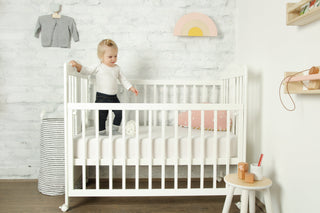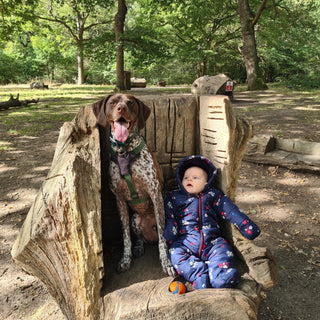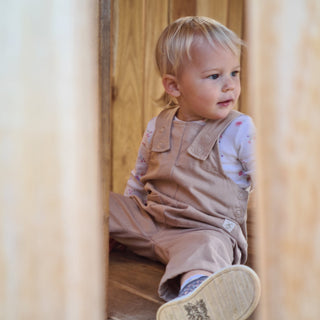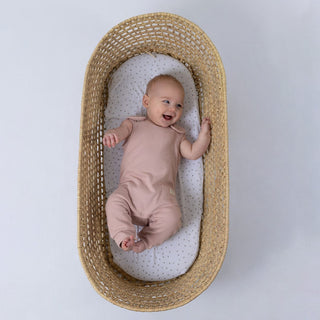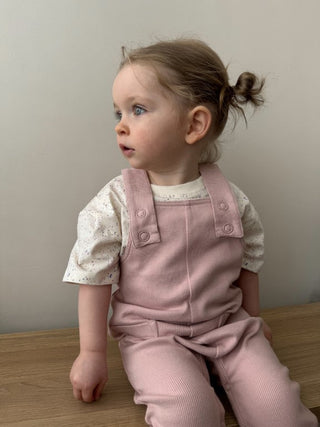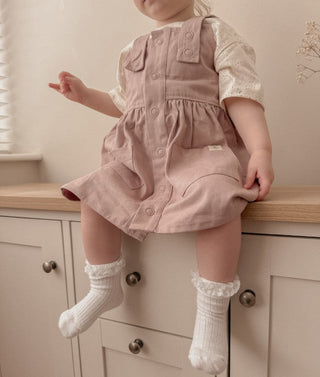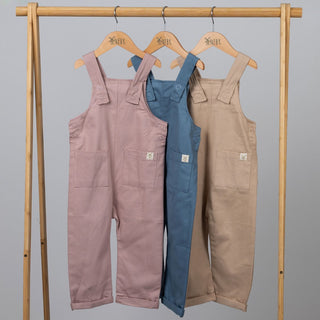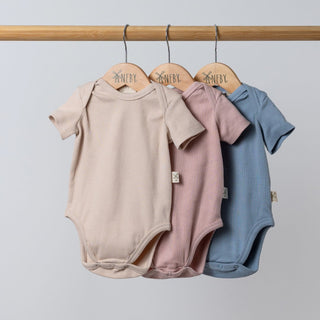When I brought my newborn home, nights felt like a puzzle. I wanted a clear answer to what to dress my baby in at night so my little one stayed cosy without getting too warm. After a lot of trial, a few sleepy mistakes, and reading trusted UK advice, I now follow a simple system: dress for the room temperature, choose breathable layers, and check the back of the neck. That’s it—no guesswork, no long charts on the fridge. Our family loves clothes that last, so I use the same approach across seasons with organic layers that work hard from month to month.
What worked for us?
For safe, comfy baby sleep, keep the room 16–20°C and dress your baby in a cotton vest or sleepsuit, plus a well‑fitting baby sleeping bag (TOG-matched to room temperature). Check the back of the neck or chest to judge warmth, not hands or feet. No hats, no loose blankets. Stop swaddling once rolling starts
-
Ideal room temperature: 16–20°C with light bedding or a lightweight, well‑fitting baby sleep bag.
-
TOG guide from the NHS: 2.5 TOG (16–20°C), 1.0 TOG (20–24°C), 0.5 TOG (24–27°C). Clothing underneath varies with the room. No extra bedding in the bag.
-
How I check warmth: I feel the back of the neck or chest; if hot or sweaty, I remove a layer. Hands and feet run cooler—normal.
-
Swaddle or sleeping bag? Swaddling can soothe newborn babies, then I switch to an arms‑out sleeping bag. Stop swaddling at the first signs of rolling.
-
Safety non‑negotiables: Clear cot, firm flat mattress, no loose bedding/bumper, no hats or hoods indoors, and room‑share for the first six months.
What I love about this approach: it’s practical, repeatable, and kind to the planet. A few lightweight basics, plus a well‑fitting sleeping bag, cover most nights. If the room runs cooler, I add one thin layer underneath. If it runs warmer, I step down the layer or pick a lower TOG. No big spreadsheet on the fridge, no panic at 2 am, just a steady rhythm that respects my baby’s comfort and our values.
Temperature Regulation For Baby Sleep
Newborn babies can’t manage body temperature as effectively as older children, so I focus on the room first. I keep a small thermometer near the cot to understand the room temperature, then I pick layers to match. A swaddle can feel soothing in the early weeks, yet a baby sleeping bag gives me a reliable setup once rolling starts. Either way, I look for breathable fabric and a fit that sits neatly at the shoulders.
My checkpoint is the back of the neck or the chest. Hands and feet can feel cool even when the core is just right, so I don’t rely on fingers or toes. If the neck feels hot or sweaty, I remove a layer. If the core feels cool, I add one thin layer under the sleep bag. This quick check prevents overheat risks and keeps my baby settled.
I keep the cot clear and flat, and I set it away from radiators and direct sunshine. No hats indoors. A clear sleep space supports safer nights and helps reduce risks linked with sudden infant death syndrome (SIDS). We talk a lot about longevity at Aneby, and it applies here too: a simple, breathable setup gives you fewer items to manage and more nights of easy, repeatable comfort.
Dressing your baby for sleep across seasons
UK weather moves fast. A warm afternoon can drift into a cool night. My solution is a season‑proof system built from a few organic basics and one or two sleeping bags with different TOG ratings. I rotate base layers under the bag rather than buying a new night outfit for every forecast. It cuts clutter and keeps our footprint lighter. This fits our brand promise: quality fabrics, generous fits, and timeless pieces that serve many months, not weeks.
Here’s my step‑by‑step flow each evening:
-
Check the room. I look at the actual room temperature, not the outside weather report.
-
Pick the sleep bag TOG. Higher TOG for cooler rooms; lower TOG for warmer rooms.
-
Choose the base layer. Cotton vest for warm rooms; long‑sleeve vest or sleepsuit for cooler rooms.
-
Do the neck check. If the neck feels hot, I remove a layer or switch to a lower TOG. If the core feels cool, I add a thin layer.
-
Keep it simple. Clear cot, no hats, no loose blankets.
I like a small “capsule” of sleepwear that covers the full year:
-
Lightweight cotton vests for warm nights.
-
Long‑sleeve cotton vests or sleepsuits for cooler nights.
-
Two sleep bags in different TOGs, sized correctly for safe shoulder fit.
This approach suits fast growth too. Relaxed, gender‑neutral designs work across siblings and cousins, so good clothes move from one child to the next without a style mismatch.
How to Dress Your Newborn in Summer?

Hot spells can make nights tricky, so I keep things lightweight and breathable. I start by checking the room temperature in the evening, not just at bedtime, since warm rooms can cool after sunset.
-
Very warm room (mid‑twenties Celsius): I use a low‑TOG sleeping bag and a short‑sleeve cotton vest, or even a nappy with the low‑TOG bag if the air feels heavy.
-
Warm room (around twenty to twenty‑three): I pick a 1.0 TOG bag with a short‑sleeve vest.
-
Air movement: I promote airflow in the room, with a fan pointed away from the cot.
-
Hydration: Babies may feed more during hot spells; I watch nappies and cues.
If you prefer not to use a bag with newborn babies, a tucked cellular blanket can help, though I still lean toward a fitted sleep bag once size and weight suit the label. Loose bedding can ride up, so I keep the cot setup minimal.
For families asking how to dress infant in summer during those muggy nights, my mantra is: fewer layers, breathable fibres, and frequent neck checks. One layer too many can disturb sleep far more than one layer too few. Cotton rib knits shine here—soft next to skin, easy to wash, and forgiving during night feeds and changes. That’s why we love quality organic cotton baby clothes for basics that work through the whole season.
How to Dress Your Newborn in Winter?

Cold evenings invite thick outfits, yet my guide still starts with the room. I aim for the high‑teens Celsius, then build warmth with layers inside the bag rather than piling heavy items on top.
-
Cool room in the high‑teens: I use a 2.5 TOG sleeping bag with a long‑sleeve cotton vest. If the room sits at the lower end of that range, I add a cotton sleepsuit under the bag.
-
Night checks: I feel the back of the neck. If hot or sweaty, I step down a layer. If cool at the core, I add a thin layer.
-
No hats indoors: Overheating often starts at the head, so I keep heads uncovered in bed.
-
Pram suits and coats: I strip outdoor gear once we come inside; bulky layers can trap too much heat.
If your home runs cool, a steady room temperature plus a well‑fitting bag gives more consistent sleep than cranking the heating and guessing at pyjamas. Cotton layers remain my go‑to in winter as well. They breathe, they stretch, and they hold up to frequent washing. That fits our approach to design and fabric choice: practical first, planet‑kind always.
Swaddle or sleeping bag?
In the newborn stage, a swaddle can calm the startle reflex. I keep it light, keep hips free, and stop at the first sign of rolling. After that, I move straight to an arms‑out baby sleeping bag. I choose the right size for a snug shoulder fit so fabric sits below the chin. No loose blankets inside the bag. This setup supports safer sleep habits and helps me avoid overheating risks.
TOG in plain language
TOG is simply a warmth rating for the sleep bag. Higher number, more warmth. I keep one low‑TOG bag for warm rooms and one higher‑TOG bag for cooler rooms. My base layers change with the room rather than the calendar. That flexibility matters in a country where spring can feel like autumn in a single week.
What about SIDS?
Safer sleep routines aim to reduce risk, so I stick to a clear cot, back to sleep, and a sleep bag or correctly tucked blanket rather than loose bedding. I avoid weighted sleep products for infants, and I avoid hats in bed. Simple choices add up to calmer nights.
Sizing tips from my nursery drawer
-
Size the bag to your baby’s weight and length, not to grow into for months.
-
Check the armholes and neck opening for a neat, comfortable fit.
-
Stick with breathable fabrics; cotton rib makes layering easier and lasts through many washes.
This is the same philosophy we use in design: relaxed fits for movement, room to grow without bunching, and timeless styles that move from child to child.
My TOG‑by‑room starter guide
This is the simple card I keep near the dresser. It’s a starting point only; I still do a neck check after settling.
-
Cool room (about 16–18°C): 2.5 TOG sleep bag + long‑sleeve cotton vest. If the room sits at the lower end, I add a cotton sleepsuit.
-
Mild room (about 19–21°C): 2.5 TOG sleep bag + long‑sleeve vest, or 1.0 TOG + long‑sleeve vest if your baby runs warm.
-
Warm room (about 22–23°C): 1.0 TOG sleep bag + short‑sleeve vest.
-
Very warm room (24–27°C): 0.5 TOG sleep bag + short‑sleeve vest, or a nappy with the low‑TOG bag if the air feels heavy.
Little adjustments make a big difference. A lighter vest can settle a restless baby far better than thick pyjamas. A lower TOG can help during teething fevers or growth spurts. Cotton remains my baseline through all of this. It breathes, it softens with time, and it works for tiny bodies that heat up quickly. That links back to our brand: fewer pieces, higher quality, and many months of use.
Newborn Sleeping Habits FAQs
What is the 5‑10‑15 rule for baby sleep?
Parents often use this phrase for a graduated‑check routine with timed gaps between visits, for example five minutes, then ten, then fifteen. It isn’t a safe‑sleep rule, and it isn’t for newborns. Safe sleep basics still stand: clear cot, back to sleep, breathable layers, and a room in the high‑teens Celsius.
What should a baby wear to bed at 74°F (about 23°C)?
This sits in a warm range. I pick a 1.0 TOG sleep bag with a short‑sleeve vest. I still do a neck check after settling. If the core feels hot or sweaty, I lighten the base. If cool, I add a thin layer under the bag.
What is the 80/20 rule for baby sleep?
Some families use this as a lifestyle idea: aim for your usual routine most of the time and flex now and then. It isn’t a safety rule. I keep the core habits the same each night: clear cot, back to sleep, and layers that match the room.
What should a baby be dressed in at night?
I dress for the room temperature, then choose a base layer that breathes. For cooler rooms, I use a 2.5 TOG sleep bag with a long‑sleeve vest or sleepsuit. For warmer rooms I switch to a 1.0 TOG or 0.5 TOG bag with lighter layers. The back‑of‑neck check guides me every time.




